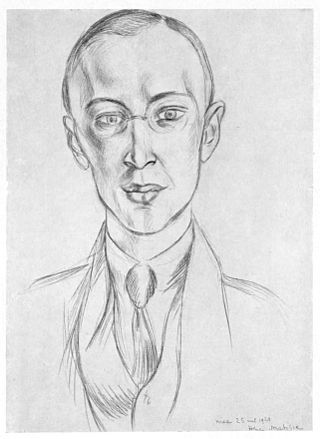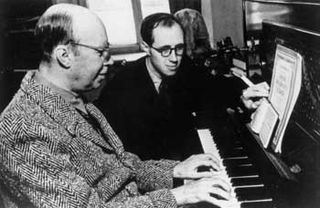
Sergei Sergeyevich Prokofiev was a Russian composer, pianist, and conductor who later worked in the Soviet Union. As the creator of acknowledged masterpieces across numerous music genres, he is regarded as one of the major composers of the 20th century. His works include such widely heard pieces as the March from The Love for Three Oranges, the suite Lieutenant Kijé, the ballet Romeo and Juliet—from which "Dance of the Knights" is taken—and Peter and the Wolf. Of the established forms and genres in which he worked, he created—excluding juvenilia—seven completed operas, seven symphonies, eight ballets, five piano concertos, two violin concertos, a cello concerto, a symphony-concerto for cello and orchestra, and nine completed piano sonatas.

Sonata, in music, literally means a piece played as opposed to a cantata, a piece sung. The term evolved through the history of music, designating a variety of forms until the Classical era, when it took on increasing importance. Sonata is a vague term, with varying meanings depending on the context and time period. By the early 19th century, it came to represent a principle of composing large-scale works. It was applied to most instrumental genres and regarded—alongside the fugue—as one of two fundamental methods of organizing, interpreting and analyzing concert music. Though the musical style of sonatas has changed since the Classical era, most 20th- and 21st-century sonatas still maintain the same structure.

Sergei Prokofiev wrote his Symphony No. 2 in D minor, Op. 40, in Paris in 1924-25, during what he called "nine months of frenzied toil". He characterized this symphony as a work of "iron and steel".

Sergei Prokofiev's Symphony No. 4 is actually two works, both using material created for The Prodigal Son ballet. The first, Op. 47, was completed in 1930 and premiered that November; it lasts about 22 minutes. The second, Op. 112, is too different to be termed a "revision"; made in 1947, it is about 37 minutes long, differs stylistically from the earlier work, reflecting a new context, and differs formally as well in its grander instrumentation. Accordingly there are two discussions.
Sergei Prokofiev's Symphony-Concerto in E minor, Op. 125 is a large-scale work for cello and orchestra.

Nikolai Yakovlevich Myaskovsky, was a Russian and Soviet composer. He is sometimes referred to as the "Father of the Soviet Symphony". Myaskovsky was awarded the Stalin Prize five times.
Sergei Prokofiev began his Violin Concerto No. 1 in D major, Op. 19, as a concertino in 1915 but soon abandoned it to work on his opera The Gambler. He returned to the concerto in the summer of 1917. It premiered on October 18, 1923 at the Paris Opera with Marcel Darrieux playing the violin part and the Paris Opera Orchestra conducted by Serge Koussevitzky. Igor Stravinsky made his debut as conductor at the same concert, conducting the first performance of his own Octet for Wind Instruments.

The sonatas and partitas for solo violin are a set of six works composed by Johann Sebastian Bach. They are sometimes referred to in English as the sonatas and partias for solo violin in accordance with Bach's headings in the autograph manuscript: "Partia" was commonly used in German-speaking regions during Bach's time, whereas the Italian "partita" was introduced to this set in the 1879 Bach Gesellschaft edition, having become standard by that time. The set consists of three sonatas da chiesa in four movements and three partitas in dance-form movements. The 2nd Partita is widely known for its Chaconne, considered one of the most masterly and expressive works ever written for solo violin.
Norwegian composer Edvard Grieg wrote three violin sonatas. They are all examples of his musical nationalism, since they all contain references or similarities to Norwegian folk song. Grieg wrote the sonatas between 1865 and 1887.

The Violin Concerto No. 2 in G minor, Op. 63, written in 1935 by Sergei Prokofiev, is a work in three movements:
- Allegro moderato
- Andante assai
- Allegro, ben marcato
Sergei Prokofiev's Violin Sonata No. 2 in D Major, Op. 94a, was based on the composer's own Flute Sonata in D, Op. 94, written in 1942 but arranged for violin in 1943 when Prokofiev was living in Perm in the Ural Mountains, a remote shelter for Soviet artists during the Second World War. Prokofiev transformed the work into a violin sonata at the prompting of his close friend, the violinist David Oistrakh. It was premiered on 17 June 1944 by David Oistrakh and Lev Oborin.
The Flute Sonata in D, Op. 94, is a musical work composed by Sergei Prokofiev in 1943. It was initially composed for flute and piano, and was later transcribed for violin as Op. 94a, both versions have been recorded several times. The piece contains four movements.
Violin Sonata, a composition for violin and piano, is a work of the Czech composer Leoš Janáček (1854-1928). It was written in the summer of 1914, but it was not Janáček’s first attempt to create such a composition. He resolved to compose a violin sonata already as a student at the conservatoire in Leipzig in 1880, and later during his studies in Vienna. His early sonatas are today lost.

Sergei Prokofiev's Lieutenant Kijé music was originally written to accompany the film of the same name, produced by the Belgoskino film studios in Leningrad in 1933–34 and released in March 1934. It was Prokofiev's first attempt at film music, and his first commission.
Sergei Prokofiev's Piano Sonata No. 4 in C minor, Op. 29, subtitled D’après des vieux cahiers, or After Old Notebooks, was composed in 1917 and premiered on April 17 the next year by the composer himself in Petrograd. The work was dedicated to Prokofiev's late friend Maximilian Schmidthof, whose suicide in 1913 had shocked and saddened the composer.

Dmitri Shostakovich composed his Sonata for Violin and Piano in G major, Op. 134 in the autumn of 1968 in Moscow, completing it on October 23. It is set in three movements and lasts approximately 31 minutes. It is dedicated to the violinist David Oistrakh, who premiered the work on May 3, 1969 in the Large Hall of the Moscow Conservatory.
The Piano Sonata No. 9 in C major, Op. 103 by Sergei Prokofiev is his final completed piano sonata. It is dedicated to pianist Sviatoslav Richter.
Sergei Prokofiev composed his Sonata for Two Violins in C major, Op. 56, in 1932 during his vacation near St. Tropez as a commission piece to conclude the inaugural concert of Triton, a Paris-based society dedicated to presenting new chamber music. That concert was held on 16 December 1932.

The Queen of Spades, Op. 70, is the score composed by Sergei Prokofiev in 1936 for the planned but unrealized film by Mikhail Romm. The film was to be based on the 1834 short story "The Queen of Spades" by Alexander Pushkin, and was intended for release in 1937, the centenary of Pushkin's death. It is one of Prokofiev's least known pieces.

Sergei Prokofiev began composing his Sonata for Solo Cello, Op. 134, in 1952. The sonata was intended to be written in four movements, but as it was one of seven compositions which the composer was writing during this time, only the beginning of the first movement was completed before Prokofiev's death in March 1953.










